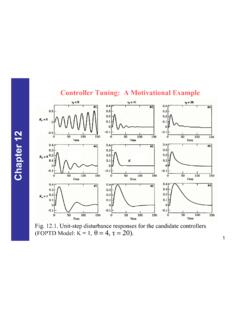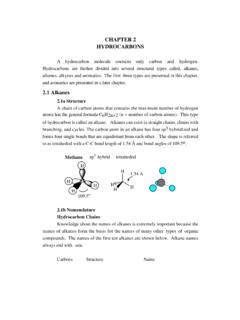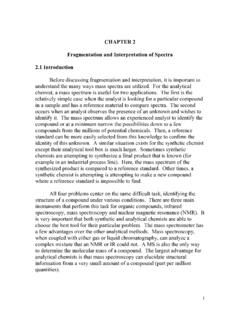Transcription of 7465.1 REV-2 CHG-1 CHAPTER 5 CHAPTER 5: TENANT …
1 REV-2 CHG-1 . CHAPTER 5. CHAPTER 5: TENANT SELECTION. 5-1. SIZE OF UNIT NEEDED. a. POLICY. (1) HUD does not specify the number of persons who may live in public housing units of various sizes. (2) The PHA must set reasonable occupancy standards which will assist as many people as possible without overcrowding the unit or the project and which will minimize vacancies. (3) In setting the occupancy standards, the PHA must comply with all reasonable State or local restrictions regarding the maximum number of occupants permitted to occupy a dwelling.
2 (4) In assigning families to public housing, a PHA may allow families to occupy units of sufficient size so that persons of opposite sex (other than spouses), persons of different generations, and unrelated adults may have separate bedrooms. Where the PHA permits families to occupy units of sufficient size to enable persons in these categories to have separate bedrooms, the PHA. should permit such families to choose whether to opt for the larger or smaller units at the time of application. PHAs may also choose to allow such families to be placed on waiting lists for both the larger and smaller units.
3 A PHA is free to allow families large enough units to enable persons in these categories to have separate bedrooms, without also having to allow families to occupy units of sufficient size for persons of the same sex, persons of the same generation, or related adults to have separate bedrooms. (5) PHAs may have different standards for different projects but such standards must not result in or perpetuate patterns of occupancy which would be inconsistent with Title VI of the Civil Rights Act of 1964 or the Fair Housing Act.
4 (6) For the purpose of determining unit size, PHAs are required to include, as members of the household, all children anticipated to reside in a dwelling unit. Examples include children expected to be born to pregnant women, children who are in the process of being adopted by an adult, or children whose custody is being obtained by an adult. The PHA should also include children who are temporarily absent from the home due to placement in foster care when considering family composition and family size.
5 Page 5-1 2/91. REV-2 CHG-1 . CHAPTER 5. b. DISCUSSION. (1) In establishing occupancy standards, PHAs may provide for the assignment of units so that: (a) No more than two persons would be required to occupy a bedroom. (b) Persons of different generations, persons of the opposite sex (other than spouses) and unrelated adults would not be required to share a bedroom. (c) Husband and wife share the same bedroom. (d) Children of the same sex share a bedroom. (e) Children, with the possible exception of infants, would not be required to share a bedroom with persons of different generations, including their parents.
6 * (2) These guidelines result in the following range of persons per bedroom: NUMBER OF BED NUMBER. OF PERSONS. MINIMUM MAXIMUM. 0 1 1. 1 1 2. 2 2 4. 3 3 6. 4 5 8. 5 7 10 *. For example, if the PHA has adopted these standards, households with three people generally should not receive apartments with more than three bedrooms. Nor should such households be required to live in apartments with fewer than two bedrooms. A household of three persons should be permitted to live in an apartment with fewer than two bedrooms if the household so desires, unless there is a state or local occupancy law forbidding occupancy of the unit by three or more persons or unless the PHA maintains an occupancy policy forbidding occupancy of the unit by three persons, and such an occupancy Policy is reasonable under the circumstances.
7 * (3) If, because of a physical or mental handicap of a household member or a person associated with that household, a family may need a unit that is larger than the unit size suggested by the guidelines in paragraph 5-lb (2), it may be an unlawful failure to make reasonable accommodation to deny such a family the opportunity to apply for and obtain such a unit. 2/91. Page 5-2. REV-2 CHG-1 . CHAPTER 5. * (4) PHAs should consider the size of the unit and the size of the bedrooms as well as the number of bedrooms.
8 (5) PHAs with many efficiencies but few one-bedroom units may want to reserve the one-bedroom units for two-person families. (6) PHAs may adopt occupancy standards which permit a lower level of occupancy in certain projects in order to help market units in hard-to-rent projects, , projects with high vacancy rates or an absence of larger families on the waiting lists. For example, a PHA may allow two-person families to obtain three-bedroom units in such projects in order to help market units. This does not mean, however, that families with more than two persons may be forbidden from occupying two- bedroom units in such projects subject to reasonable occupancy limits adopted consistent with this section.
9 (7) Foster children are normally included in determining unit size. (8) A live-in care attendant who is not a member of the family should not be required to share a bedroom with another member of the household. (9) A person of a different generation, such as a grandmother, should not be required to share a bedroom with her children or her grandchildren. (10) A PHA may provide space for a child who is away at school but who lives with the family during school recesses. A PHA would usually not provide space for a family member who will be absent most of the time, such as a member who is away in the military.
10 A family may need a unit that is large enough to accommodate a member of the family or a person associated with that household who has a physical or mental handicap. Failure to provide reasonable accommodations to such a family may be unlawful. It may also be unlawful to deny such a family the opportunity to apply for and obtain such a unit. (11) To avoid vacancies, a PHA may provide a family with a unit that is larger than suggested by the guidelines in paragraph b 2, with the provision that the family will move to a smaller unit when another family needs the unit and a suitable smaller unit is available.

















